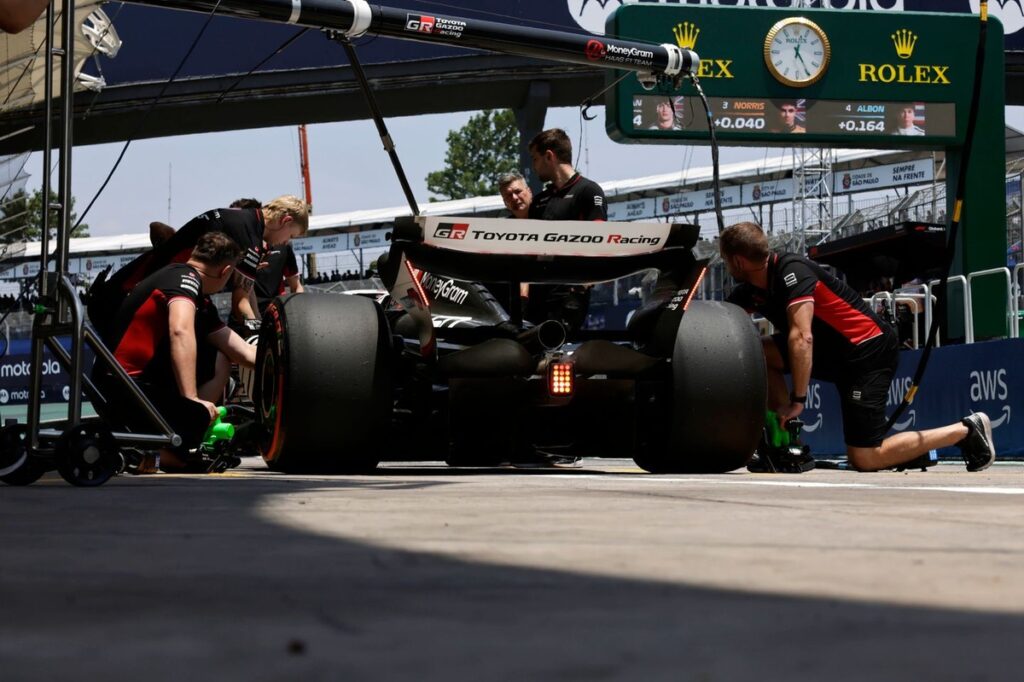Ahead of grand prix qualifying at every Formula 1 race, the mechanics across the grid must complete a task they just cannot get wrong.
This is to strip two cars down after each FP3 session or sprint race and build them back up again, while incorporating the final set-up adjustments and repairs required by their drivers and engineers ahead of qualifying.
On a typical non-sprint weekend, the whole process must be completed in just 150 minutes.
“It’s one of the most important things we do,” Matt Thompson, number one mechanic for Nico Hulkenberg at Haas tells Autosport.
“It’s the last time you can actually work on a car. Once the car is in parc ferme, you can’t touch it, you can’t change anything…”
At the recent Mexican Grand Prix, we saw exactly how this process is conducted at Haas, as well as learning just how fraught it can be if the unexpected rears.
The countdown clock tells all
Team members of Haas F1 Team at work in the garage
Photo by: Simon Galloway / Motorsport Images
We arrive in the back of the Haas garage just in time for FP3 to conclude in Mexico City.
Lingering thoughts from the story we’ve just been filing on the news of the weekend – F1 driving standards in the wake of Max Verstappen’s cynical tactics deployed again at Austin the week before – will have to wait. There’s plenty to listen into on the Haas communications channels.
Neither VF-24 is in the garage at this stage – they’re still out on track at the Autodromo Hermanos Rodriguez in the hands of Nico Hulkenberg and Kevin Magnussen
But the chequered flag has just fallen and as they return to the pits the order for “double stop” practice is issued by Haas team manager Peter Crolla, sat aside team principal Ayao Komatsu on the pitwall far in front of our vantage point.
Hulkenberg gets back first and is serviced with a rapid tyre swap before being pushed out of the way so Magnussen can also receive the treatment. Crolla and Komatsu cast intense eyes on proceedings.
The two cars are then quickly wheeled and back in and “wheels and bodywork off” instructions are issued by Elliot Parkes, the number one mechanic for car 20 (Magnussen), and Thompson for car 27 (Hulkenberg). An additional call for a “T-Tray test today if possible” from Thompson pricks our ears given the furore over this part at Red Bull the previous week in Texas.
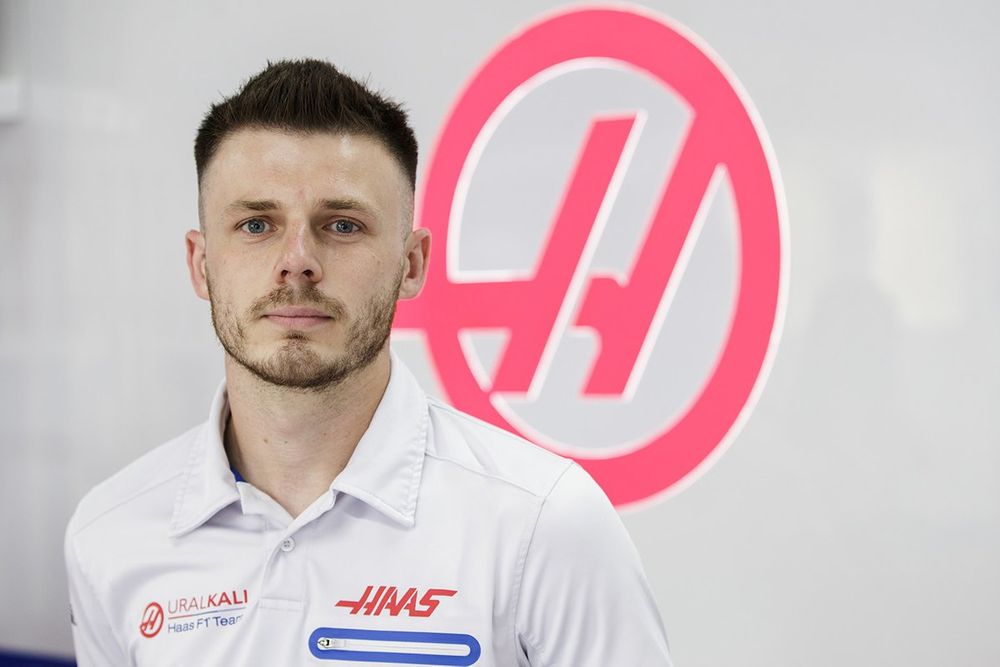
Elliot Parkes, Haas mechanic
Photo by: Haas F1 Team
“But it’s a routine thing that we always have to do,” he later explains. “You always have to make sure the car’s legal.”
Tools grasped, bodies slung over and under these multi-million-pound machines – the Haas crew is ablur in action.
Eight minutes into the enshrined timeframe for their most important work of the weekend and Magnussen’s car up is on its stand. Three minutes later, the engine cover under Hulkenberg’s number 27 sticker is removed, with Magnussen’s quickly afterwards. But it takes until 12 minutes post-FP3 for Hulkenberg’s car to join its sister in being raised up off the ground.
A countdown clock on the garage-lining screens declares: “lunch snacks 12.45”. This is just to let the mechanics know they can get something to eat over the event’s lunch break – a sedate affair for basically everyone in F1 except these motley bands at each team – in paddock hospitality when they get a chance.
With the bodywork off each car, chunky yellow padding is placed along the sidepod-lining radiators. This is to “protect us from the heat, but also protects us from damaging the radiators as well”, explains Thompson.
“Imagine if you just dropped one tool on it,” he adds. “Then you’ve got a leak before you know it and another huge job to do in that two-hour period.”
Not quite 15 minutes into this critical period and the massive drum coverings are off the brakes on Magnussen’s car, their orange sponge coating within revealed. Shortly after, with yet more engine cover panelling stripped from both cars, Magnussen’s crew is told by Parkes that “once the t-tray test is done we’ll drop down to check the floor as there’s a couple of bits I’d like to make nice from last night”.
Parkes and Thompson are working through their checklists via a dedicated chatroom on their computers. This has colour-coded instructions for what has been ordered from the Haas engineers in terms of set-up adjustments, as well as the typical checks, replacement work and repairs, and to show what of this has been completed or not.
At the 27-minute mark post-FP3 – the plank is removed from underneath Magnussen’s car. A meaty, smoky smell abounds – the result of this part being scraped at up to 217mph around the Mexican track.
“We always take it off to measure it and check, because we can work out skid wears and stuff like that from there,” Thompson explains. “And then, obviously, we fit brand new stuff for qualifying to give us the best chance of our calculations being legal at the end of the race.”
Arriving at 30 mins post-FP3 and the floor and diffuser have come off car 20, but notably not the 27. Magnussen’s floor is carried out the back of garage by two mechanics – a dark chalk outline-like silhouette that betrays the immense scale of these modern machines like no other.
Here, Hulkenberg’s car fires up. Its wheels rotate slowly on its stand as systems are analysed for faults by engineers, a beast almost pawing the ground, while a hose pulls the fumes away from the mechanics. But Magnussen’s won’t do the same for nearly an hour.
“Normally, it’s scheduled to be at the same time,” says Haas chief mechanic, Toby Brown. “But whoever’s ready first, you just get on and do it. You might have something else to do later.”
With Hulkenberg’s car silent again, a staffer from Formula One Management arrives to check the rear camera on car 20. He does his work on the system inside once the cover has been removed for him.
Nearing 40 minutes post-FP3 and there’s much adjustment to car 27’s front wing going on at front of the garage, under supervision from Hulkenberg’s engineer, Gary Gannon.
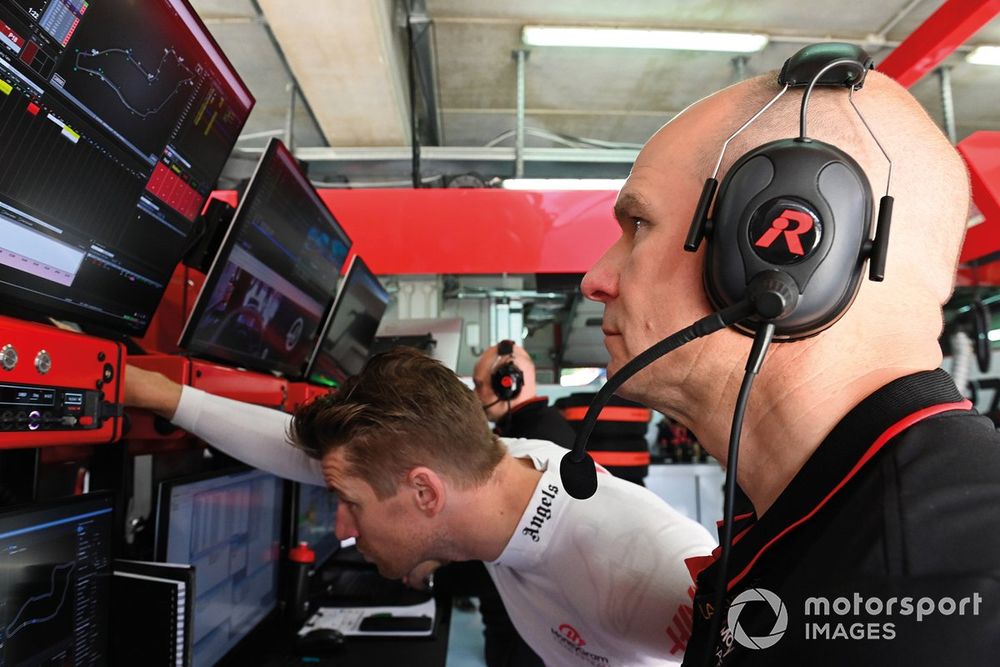
Nico Hulkenberg, Haas F1 Team, and Gary Gannon, Race Engineer, Haas F1 Team
Photo by: Mark Sutton / Motorsport Images
He explains the “really fraught” legality checks that must be done on the set-up adjustments that have come in for qualifying. This is after the post-FP3 debrief that has happened between the drivers and engineers behind the garage in the huge tents that also double as team hospitality units for this race.
Here, Gannon is specifically making sure the ones applied to the front wing fit in the boxes FIA scanners will later invisibly project and test post-qualifying, so the team isn’t caught out as Williams was with Alex Albon’s floor found to be too wide back at Zandvoort. Some margin must be left on every adjustment, but doing so means risking missing performance.
Gannon says this can often come down to a 0.01mm adjustment.
We’re just noticing how calm everything is – little wasted chatter – when a Paddock Club tour is brought in. Even more gawping ensues.
Then, as the one-hour-mark post-FP3 approaches, Magnussen’s car suddenly sits alone – checklist complete. But on the other side of the garage, there’s considerable work going on with Hulkenberg’s car, which still has its floor on.
“We had a few repairs to do as well and a small brake issue, which we had to replace,” explains Thompson. “So, it wasn’t like a huge amount, but all the little things just add up.
“Nico also had a vague question about the brakes. So, you can’t just go into the race knowing you’ve got a vague question, can you? You have to take every precaution possible and just work from there.”
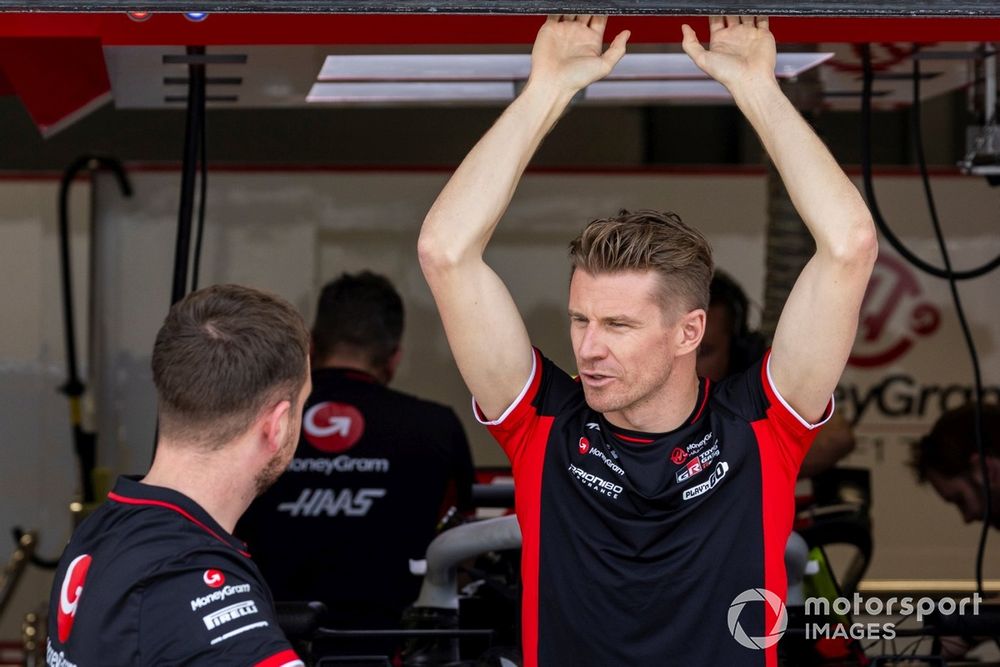
Nico Hulkenberg, Haas F1 Team, in the garage
Photo by: Sam Bloxham / Motorsport Images
While this is going on, Brown is nonchalantly scrolling through a 3D map of Haas’s braking systems on a screen in the middle bank of computers and standing desks that split the team’s garage. To his right, the cockpit of 20 car is pleasingly casually hoovered to remove the dust and detritus that is particularly a problem at this venue.
As the mechanics reach 63 minutes into their allotted 150, the floor is finally off Hulkenberg’s car. Here, a new element arrives in the form of an FIA scrutineer making a rapid assessment of this car’s engine cover. Minutes after he’s swiftly departed, there are more inspections from different officials.
This time, there are checks underneath Hulkenberg’s right sidepod that are repeated on the left-hand side of Magnussen’s machine. Spotting phones being shoved into the respective vicinities, Brown explains how scrutineers are scanning QR codes for cost cap compliance on various parts using a dedicated app. They’re checking that these have been bought and invoiced correctly by the team.
It’s now 70 mins post-FP3 and the brake drums are now back on car 20, while 10 minutes later the floor is fitted back on its sister – just as a Sauber car fires up noisily in the neighbouring garage to our left.
A short while later, a third FIA scrutineer arrives. This one prods and pokes Magnussen’s beam wing vigorously, at one stage shoving a whole finger into a hole. After moving to ruffle the Dane’s rear wing he shares a joke with Brown.
“I know them – some of them, very well,” he says. “Because I’ve worked with them previously. It’s best to have a good relationship with those people.”
As the 100-minute post-FP3 approaches, Magnussen’s floor is carried back through the garage and fitted back on. It’s at this stage a plate of quesadillas is brought to Hulkenberg’s side of the garage – two of his mechanics didn’t have a chance to eat earlier. They finally do so while they work, the limit of this task unrelenting.
Next, team owner Gene Haas wanders through the scene, shortly before the bodywork is finally all back on Hulkenberg’s car.
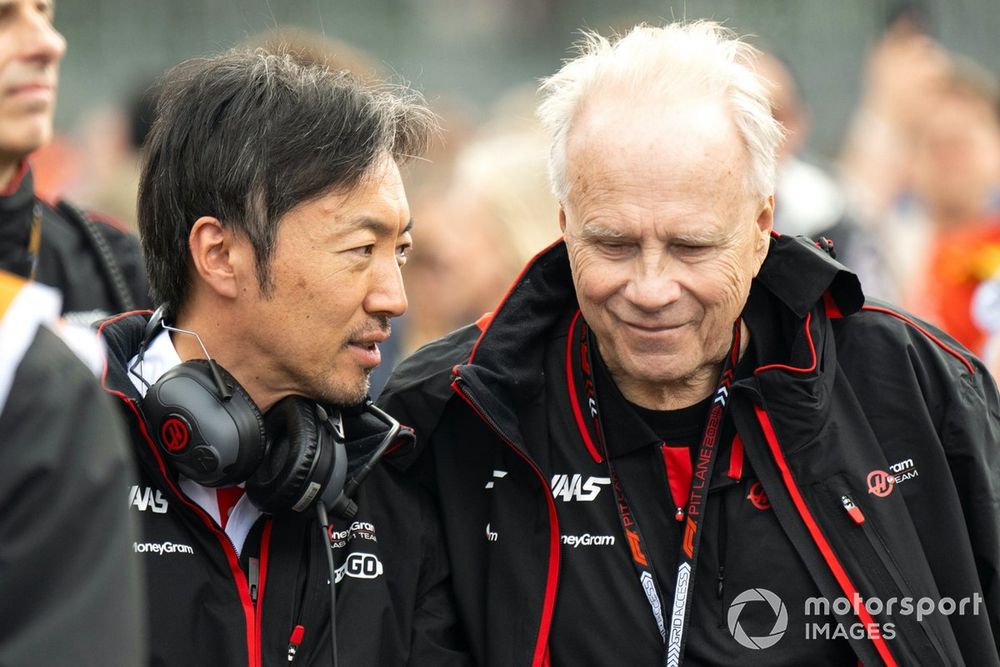
Ayao Komatsu, Team Principal, Haas F1 Team, Gene Haas, Owner and Founder, Haas F1 Team
Photo by: Simon Galloway / Motorsport Images
As we hit 120 minutes since FP3 has ended, it’s time to reverse how this period is called. It’s suddenly gone amber with new hype on the pressure none of the Haas crew are showing strain under – the screen clocks ticking down from a new 30-minute timer ahead of qualifying. Adjustments to some parts – suspension, for example – are no longer possible if the car involved is going to make it out for Q1’s commencement.
With 28 minutes to go, the scrutineers are back – this time to put stickers on various bits of both cars, mainly around the front wing, rear wing and floor.
“Because you’re under parc ferme conditions, those items you can’t change after that point,” explains Brown.
“And there’s certain parts of the floor that bolt on and off, so you could change them [illegally, without the stickers’ protection].
“A recent one that they’ve started doing is putting stickers on the skids at the end of qualifying and they come check before the race. Because, I assume, some other teams have been changing the skids. You can’t do that…”
With 27 minutes to go, the bodywork is now all back on Magnussen’s car, while here Hulkenberg’s is lowered to the ground. Bodywork sealing tape applied, his mechanics start clearing their workstations of various tools and boxes.
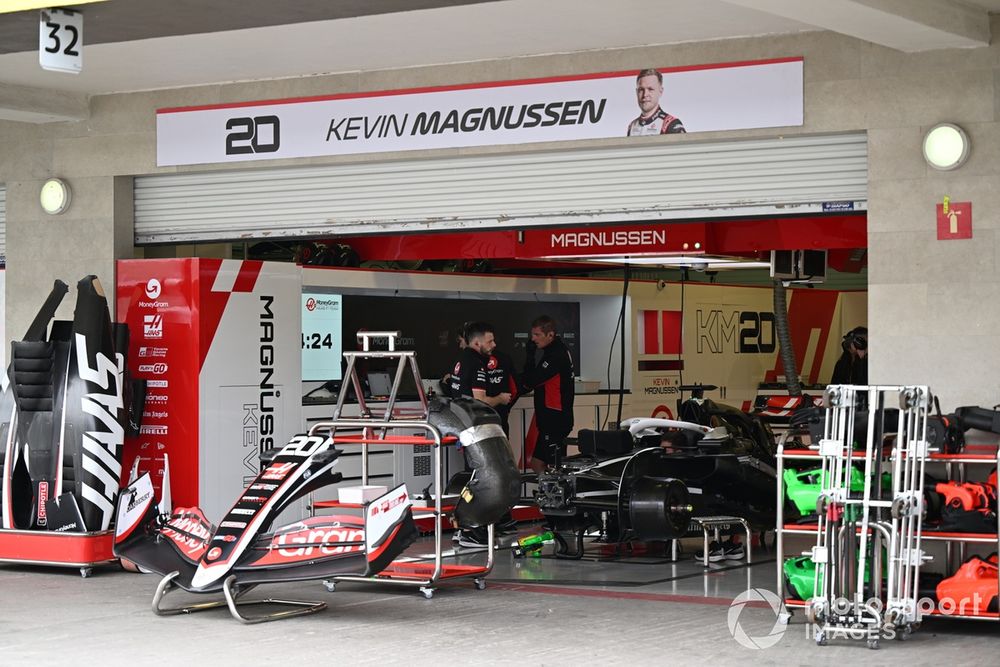
Team members of Haas F1 Team at work in the garage
Photo by: Simon Galloway / Motorsport Images
But with 26 minutes to go, it’s suddenly all action around Magnussen’s car. Having been by far the easier job on this occasion, there’s a twist.
“Just as we closed everything up, someone from [team engine supplier] Ferrari said they’d like to change something that they’d seen on the other car, which wasn’t quite right,” Parkes explains.
“It was a bit of a late call. There wasn’t really much time left, so we took the bodywork back off to get involved.”
While this action is ongoing to his right, Komatsu walks back through with his headphones on, steely competitor’s glint in his eye. But five minutes later, the unexpected work is complete on Magnussen’s car and it too is lowered to the ground.
Getting to 15 minutes out and the amber team screens turn an angry red, at which point Crolla addresses the squad once again. It’s so close to attention going back out on track and the serious stuff of every F1 weekend.
As the 10-minute mark pre-qualifying arrives, Komatsu alerts the whole team about what’s expected throughout the upcoming session, where both cars will reach Q3.
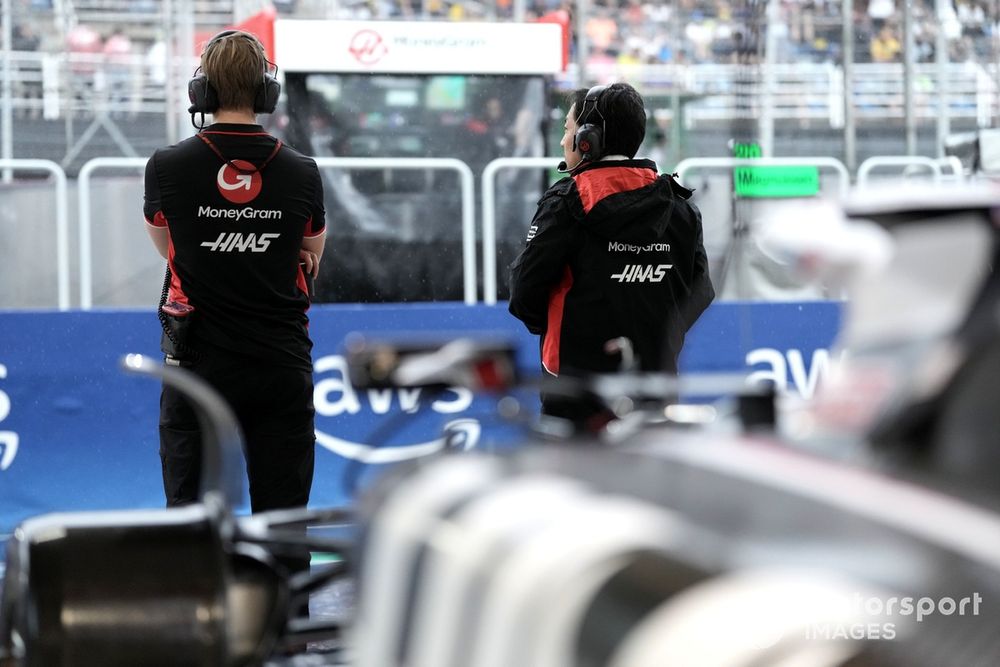
Ayao Komatsu, Team Principal, Haas F1 Team, a teammate in the garage
Here, Hulkenberg saunters back into garage. He’s weighed and puts his balaclava and helmet on – around final discussions with his crew and Gannon. A few minutes later, Magnussen does the same thing.
Three minutes out, the tyres are fitted for Q1 and the qualifying fire-up process can kick off again – this time for real action for the VF-24s. The staff dedicated to honing their respective states can only stand back and watch as the results come in, this critical process complete…
When this process gets really complicated
“FP3 was fine, everything was completely under control,” Thompson concludes as he recalls the most intense FP3-qualifying process Haas has had so far in 2024.
“The job list was quite small; everything was just too smooth. And then 10 minutes before the session, we realised one of the rain lights wasn’t working on the rear wing and it’s like, ‘OK, well, it’s probably just a light that could have failed’. So, we checked the light, wasn’t that. Traced it back to another wiring fault. And again, obviously, you’re in parc ferme after so we had to fix it.
“Our wing swap normally takes half an hour, but we only had 10 minutes to do it. Everyone just had to pile in together, stop their normal jobs and just help change the wing. And I think we made it out 30 seconds late or something. But, up until that point, it was quite relaxed and smooth.”
“The workload, I’d say, is higher,” Parkes says of how at Haas, the efforts made to change engines and gearboxes on Friday evenings post-FP2 at non-sprint weekends actually mean a greater list of tasks to complete compared to what we’ve just observed.
“But after FP3, it’s just critical you don’t make any errors…”
Read the full article here

